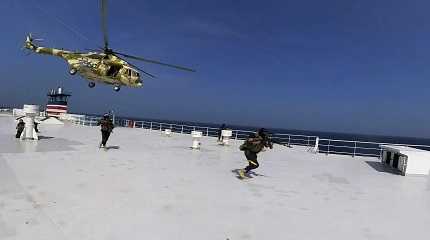
DUBAI, United Arab Emirates (AP) — The helicopter-borne Houthi attack on an Israel-linked ship in the Red Sea highlights the danger now lurking in one of the world’s key shipping routes as the Israel-Hamas war rages, as well as the rebels’ tactics mirroring those of its chief sponsor, Iran.
While Tehran has denied aiding the Yemen rebel group in launching their attack Sunday, the targeted ship before the assault passed by an American-sanctioned Iranian cargo vessel suspected as serving as a forward spying base in the Red Sea. The rebels, dressed commando-style in bulletproof vests carrying assault rifles, covered each other and moved in military formation before quickly seizing control of the bridge of the Galaxy Leader.
While their body-camera footage serves as a propaganda coup to bolster their own position in Yemen amid some protests against their rule, it also signals a new maritime front has opened in a region long focused on the Persian Gulf and its narrow mouth at the Strait of Hormuz. It also puts new pressure on commercial shippers traveling through those waters, threatens to increase insurance costs that will get passed onto consumers and likely further stretches the U.S. Navy as it tries to serve as the region’s security guarantor.
“This has all the signs these people were trained by a professional military, which could clearly be Iran,” an American defense official told The Associated Press on condition of anonymity to discuss intelligence matters. “This looks like something we haven’t seen before.”
It’s not just the U.S. and Israel suspecting Iranian involvement, however.
The risk intelligence firm RANE referred to the tactics employed by the Houthis as reminiscent of those used by Iran’s paramilitary Revolutionary Guard when seizing vessels in the past over years of tensions regarding Tehran’s collapsed nuclear deal with world powers. Ambrey, a private intelligence firm, similarly referred to the operation as an “Iranian-style vessel seizure” that “provides the Houthis with a negotiation lever” in much the same way Hamas’ taking of some 240 hostages in their Oct. 7 attack on Israel did.
“The incident displayed a significant increase in the Houthis’ capability to disrupt merchant shipping,” Ambrey said. “In the past, the Houthis had only used sea mines, missiles and remote-controlled improvised explosive devices in the Red Sea.”
It added: “The sophistication of the operation suggests that Iranian involvement is highly likely.”
The Galaxy Leader, linked to Israeli billionaire Abraham “Rami” Ungar, also passed by the Iranian cargo vessel Behshad before the attack Sunday, according to satellite imagery first reported by the firm Tanker Trackers.
The Behshad has been in the Red Sea since 2021 off Eritrea’s Dahlak archipelago. It arrived there after Iran removed the Saviz, another suspected spy base in the Red Sea that had suffered damage in an attack that analysts attributed to Israel amid a wider shadow war of ship attacks in the region.
Iran, for its part, denied Monday having anything to do with the attacks.
“Those accusations are void, and a result of the complicated situation the Zionist regime is struggling with,” Iranian Foreign Ministry spokesman Nasser Kanaani said. “We have said many times that resistance groups in the region represent their own countries and people, and they make decisions based on the interests of their own countries and nations.”
However, Hamas has Iran as one of its main sponsors. The Lebanese Shiite militia Hezbollah, another Iranian-backed group, has engaged in cross-border fire for weeks with Israel. Iraqi militias have claimed drone attacks on U.S. bases there. Syria, another Iranian beneficiary, has launched sporadic attacks too.
It remains unclear just how much control the Iranians exert over the Houthis. However, the rebel group has seen its ballistic missile and drone program rapidly advance despite being targeted by a yearslong United Nations arms embargo. Analysts attribute that to Iranian weapons shipments, of which some have been previously seized by the U.S. and allied navies.
Houthi weapon sophistication has grown in other ways as well.
The Houthis have been able to fly this year a Soviet-era MiG-29 fighter jet over the capital, Sanaa, during a military parade, along with a Northrop F-5 Tiger combat aircraft at another. A Houthi parade also saw Soviet-era Mil Mi-17 helicopters flying through the sky — the same helicopter used in Sunday’s attack. A Saudi-led coalition fighting the Houthis had targeted Yemen’s air force with airstrikes at the start of the war and the Houthis have yet to explain how they got these aircraft flying again.
The Houthis also have shot down an American MQ-9 Reaper drone during the Israel-Hamas war with a surface-to-air missile, as well as have fired drones and missiles toward Israel.
All of this makes the Red Sea, which stretches from Egypt’s Suez Canal down to the Bab el-Mandeb Strait separating East Africa from the Arabian Peninsula, increasingly dangerous for shipping. That narrow strait, some 29 kilometers (18 miles) across at its tightest point, is crucial for cargo and energy shipments.
The U.S. has sent more vessels into and through the Red Sea, including the USS Dwight D. Eisenhower aircraft carrier and its strike group. The Eisenhower is now in the Gulf of Oman, according to satellite images, meaning there are fewer U.S. Navy assets in the Red Sea to deter any possible new attacks.
And if the next attack sees fatalities — particularly of U.S. or Israeli nationals — that raises the risk of a wider war breaking out on the seas.
“Significant Houthi interference with commercial shipping through the Strait is almost certain to trigger U.S. intervention due to the political and potentially economic implications,” the New York-based Soufan Center warned.




